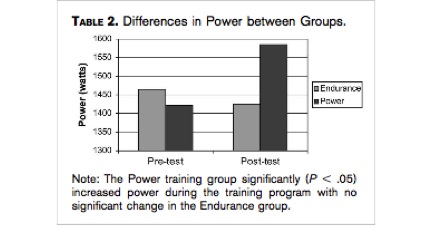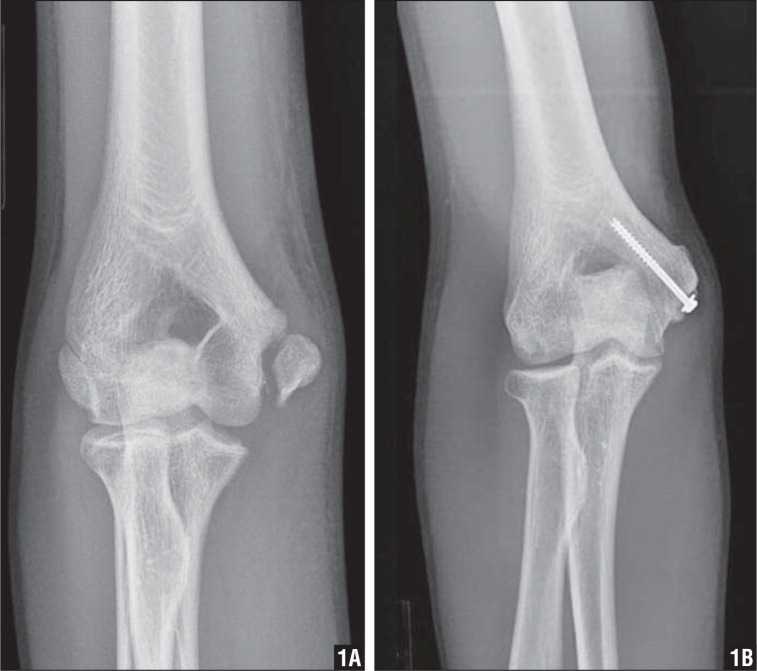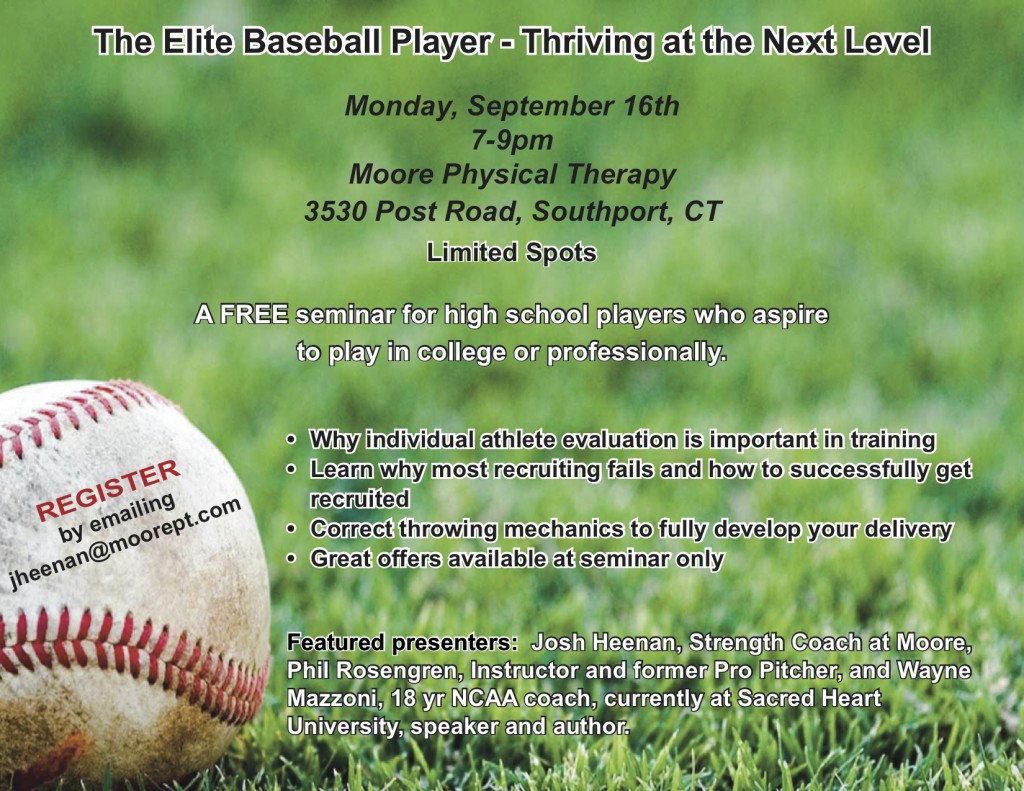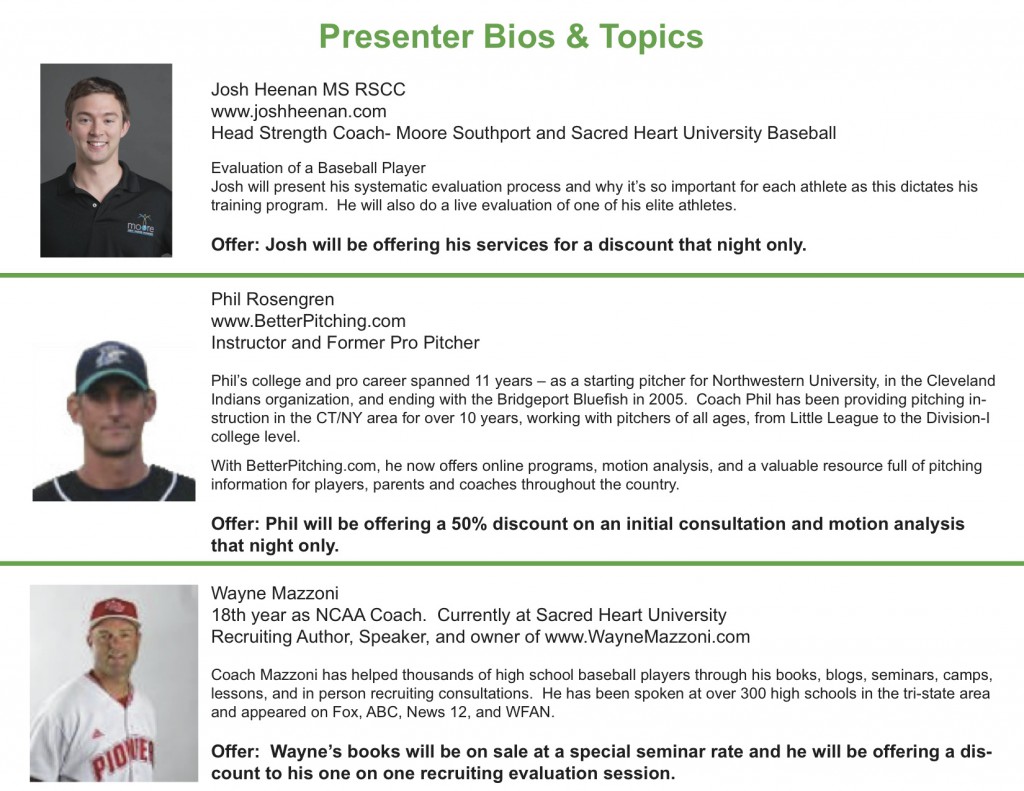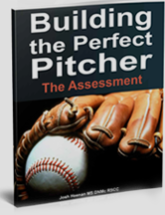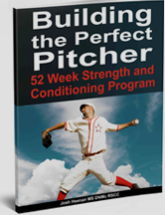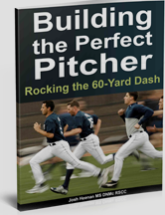2014 MLB Drafted Athlete Update
Having been out of the country for the 2014 MLB Draft I’m a little late to the party.

Kody Kerski– 8th Round Seattle Mariners- Former athlete from Sacred Heart University. Here is an article featuring his development preparing Kody for the Cape Cod League and MLB Draft.
Having worked with Kody for his first three years at Sacred Heart, I can tell you that teammates always recognized him as having the hardest pitches to hit not for velocity, but for movement. At the beginning of his Junior year, he focused hard on adding weight and taking his training to the next level. Adding about 15 lbs to his frame that off-season equated to about 5 MPH on the mound, topping out at 95. Check out the differences in stats from his FR/SO years to his JR/SR campaigns.

Willie Rios– 26th Round Arizona Diamondbacks- Willie been listed as a legit 2-way player on the mound and at bat and had offers to sign in the top 3 rounds this year. Willie will have many options for the future and if he decides to go the college route we will push his development in search of breaking into the first round via Maryland. More info here on his draft status.
Move Fast, Throw Hard, Live Well- Little League Curveballs and Youth Weight Training
This weeks post I am going to share a readers question and my response about weight training his younger athlete. If you have a question you would like answered feel free to shoot me an email.
Enjoy!
Q:
What would you recommend for a 13 yr old 7th grader, honestly? I am not wanting him to do more than hi-rep, bodyweight exercises at most. He’s 5’9” (and growing), 110 lbs. throws pretty hard – has a nice arm, and I want to keep that intact. Staring the travel ball with a good, established organization in IL this year…what are your thoughts on throwing curve balls, if taught by a former pro pitcher, etc? (I am leery of that).
A:
As I said in the webinar, if you can play organized sports, you can train (and its safer!). High rep stuff is fine, but that’s where we usually see injuries because of fatigue and poor form. Moderate weights would be a better option for him. Move well and then move higher weights.
Here is my take on youth curveballs; research wise if it’s being taught properly (mechanically efficient) there is not a huge chance of injury. That being said, there are a ton of bad coaches out there (not that his is bad–I have no idea), but being a former pro doesn’t automatically qualify you to be a “good” or well researched coach.
From what I have seen in the rehab and coaching world, poor progression of throwing (jumping up in intensity or mainly volume) too quickly leads to lots of issues. The kids who throw “too many curveballs” are usually the kids who cant compete with just a fastball. And as I have written about before, skipping on fall/winter baseball is a must.
At this point in my career, if my child was a pitcher in little league I would encourage fastball and change up location and speed, that alone will keep batters off balance. Once they start shooting through puberty (13-15 years), I would let them play with curveballs with a coach that is highly qualified. I grew up with a coach who said “never two curves in a row” for both practice and play. Great rules to help set-up hitters and stave away from overuse.
The image attached is a visual of when portions of the arm ossify. The medial epicondyle is the last to fully fuse and we should always proceed with caution.
On the other hand, Phil Rosengren does a great job at expressing why he thinks kids should be tough the curveball at a younger age. To be frank, I don’t disagree with any of his points. And to Phil’s credit, every athlete he has sent me has never had an elbow pathology.
Many people are racing for their kids to be on ESPN in the LLWS. I think they are racing the wrong race. I’ve had the opportunity to work with many kids whom have been on ESPN before the age of 13… some of what they are dealing with mentally are so unfathomable it’s disgusting. Not to mention some of the injuries I’ve seen especially from the “best” players on those teams.
Move Fast, Throw Hard, Live Well – Mound Height, Throwing Programs, Links Between Foot Function and Upper Extremity Surgery
This article was shared with me by one of our in house PTs whom treats a ton of throwing shoulders. The foot starts the chain reaction of throwing. Without effective transfer of force from the foot there are links to upper body dysfunction, and in this case, surgical repair.
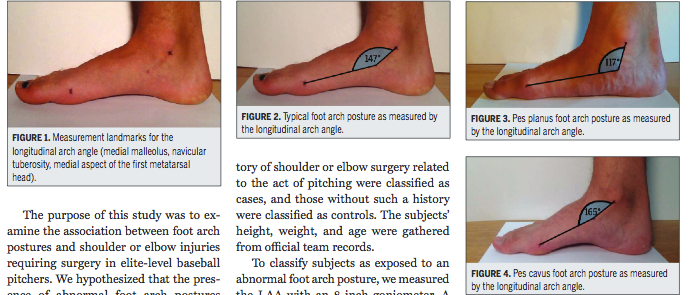
Picking out quality shoes and cleats can have a dramatic impact on ones movement and performance, make sure to get fitted by a qualified professional whom understands how your foot functions.
Pitching Mound Height Affects Throwing Motion, Injury Risk
As we head towards the pre-season, pitchers often rush themselves back to the mound in hopes to catch up to their more conditioned counterparts. Unfortunately, poor preparation and progression leave their shoulders and elbows in pain. This article gives good info on how the stress of throwing on a mound is higher than flat ground throwing. When returning to the mound, progressing methodically with a throwing program is a necessity if you want long-term health and performance.
Move Fast, Throw Hard, Live Well – Tommy John Surgery, Lactic Acid, and the Physiological Response to Pitching
Mike Reinold, former Physical Therapist for the Boston Red Sox does an outstanding job at laying down realistic expectations in regards to ulnar collateral ligament (UCL) reconstruction. This is a must read for all pitchers!
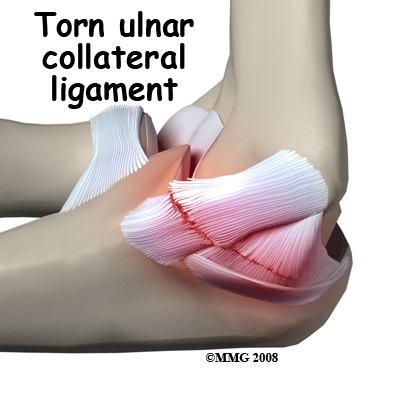
The physiological responses to a single game of baseball pitching
This is an older journal article that takes an in-depth look at how the body responds to pitching 7 innings. The researchers provide intermittent data within the game and 24 hours post game.
It’s Not About the Lactic Acid: Why You’re Still Sore After Yesterday’s Ride (Workout)
Dr. Burke does a nice job at explaining the reasons why “lactic acid” is not the issue the day after a workout. I can’t begin to explain how often athletes, coaches, and parents talk about how they need to “clear the lactic acid” from the previous days workout. As Burke states “lactic acid is completely washed out of the muscles within 30 to 60 minutes after you finish riding. Since muscle soreness does not show up until 24 to 36 hours later, scientists have been exercising their brains to come up with another explanation.”
The next time a coach or trainer tells you are doing distance running as a “flush run” or “to clear lactic acid” start asking why, because the science in no way backs this claim.
Move Fast, Throw Hard, Live Well — Thoracolumbar Fascia, Pitching and Youth Athletics
2013 proved to be the busiest of years in all aspects of my life. A short list of events include: buying a house, getting engaged, moving my fiancé to another country, starting my Doctorate of Integrated and Natural Medicine, and seeing over 100% growth from 2012 in our performance and fitness division. On top of all of those things, I still manage to spend 10-20 hours reading research, blogs, and conduct case studies, because I truly love it and want to provide my clients and readers with the best information available.
The reason I write all of this is I plan to write, at minimum, once a week on any research, articles, cases or thoughts. As always, any suggestions or comments please provide below.
Without further adieu…
-
Thoracolumbar Range of Motion in Baseball Pitchers and Position Players
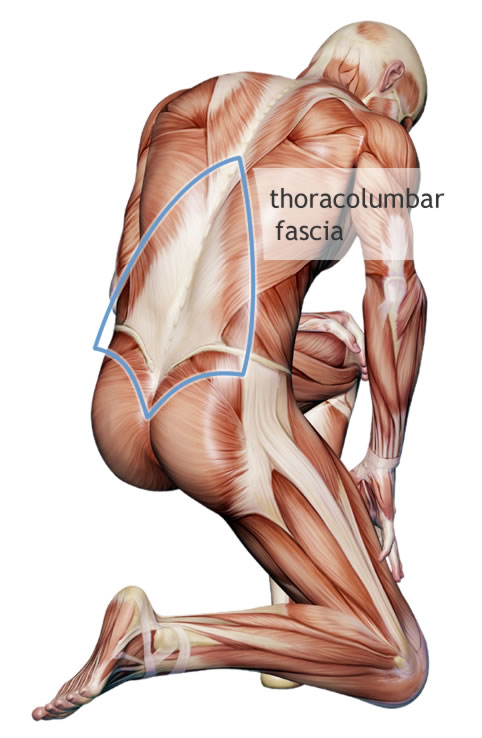
“Pitchers have a greater amount of rotation ROM towards the non-throwing arm side as compared to position players. Pitchers also have a greater amount of rotation ROM to the non-throwing arm side as compared to their throwing side rotation. Because pitchers often present with posterior shoulder tightness and subsequent altered shoulder horizontal adduction and internal rotation ROM, the increase in non-throwing side rotation ROM may occur in response to these adaptations. More specifically, this increase in non-throwing side trunk rotation ROM may allow such athletes to bring the arm across the body during the follow-through phase of the throwing motion despite posterior shoulder tightness.”Thoracolumbar fascia is a large, fibrous tissue located in our lower back that connects into our lats and glutes; a powerhouse for generating force in rotational athletes. In pitchers, I have often said that improved extension and external rotation of the arm will lead to more powerful pronation and velocity increases. This research gives added validity to rotational training in both directions to allow the non-throwing side trunk to create a larger lever to generate more trunk force and increase MPH.http://www.ncbi.nlm.nih.gov/pmc/articles/PMC3867070/ -
Overuse injuries and burnout in youth sports: A position statement from the American Medical Society for Sports Medicine
This is a must read for any coach or parent. A portion of the younger athletes I evaluate play one sport all year round, deal with nagging and long term injuries, and have many of the symptoms of burn-out. Worse part is when I pull the parent aside and explain how I think playing multiple sports “for fun” will be incredibly beneficial they often ignore the advice until the child has a serious injury.http://www.amssm.org/Content/pdf%20files/2014_OverUse_Injuries-Burnout.pdf”
-
Differences in physical fitness and motor competence in boys aged 6-12 specializing in one versus sampling more than one sport
The researchers found “multiple comparisons revealed that boys aged 10-12 years, who spent many hours in various sports, performed better on standing broad jump and gross motor coordination than boys specializing in a single sport.”http://www.ncbi.nlm.nih.gov/pubmed/?term=Differences+in+physical+fitness+and+motor+competence+in+boys+aged+6-12+specializing+in+one+versus+sampling+more+than+one+sport.
So… you’re saying that playing multiple sports will give my athlete a chance to be more powerful, more athletic, and help avoid long term physical and psychological dysfunction?
YEP!
Scribner Documentry
The past few months have been very busy at Moore, thus the lack of posting here. A few of my athletes have been featured recently with some very cool documentaries. Most recently, Troy and his brother Evan. Happy Holidays and enjoy the video!
Portraits : The Scribner Brothers from Manuel A. Santiago
Why Your Conditioning is Hurting Your Performance on the Mound!
By now, readers of this blog are familiar with the concept of the “well rounded athlete”—the athlete who focuses on the fundamentals of movement and conditioning in order to master the finer points of his sport. While I believe that all baseball players should embrace this philosophy, I urge pitchers to exercise particular caution in applying it. This is especially true with regard to distance running and pole running, two long-time staples in the pitching community. As I explain in the following paragraphs, these conditioning methods may harm a pitcher’s on-field performance more than they enhance it.
Common Misuses of Conditioning
The first misconception about distance and pole running is that they help to remove excess lactate from the blood after a pitching outing. This belief embodies a basic misunderstanding of the physiology of pitching. Pitching is a maxium effort burst movement that is repeated dozens of times over the course of a game. The burst motion of pitching relies on the phosphogen or ATP-CP system, which is regarded as a lactic anaerobic energy system because it neither uses oxygen nor produces lactic acid if oxygen is unavailable. In laymen’s terms this means that, contrary to popular belief, pitching does not increase blood lactate levels significantly. Therefore, “flush” runs designed to lower blood lactate levels merely expose pitchers to a decrease in power and increased risk of injury without bestowing any measurable benefit.1
Distance and pole running present other problems as well: a lack of neural adaptation (high powered nervous system output); limited or diminished strength gains; and an underdeveloped range of motion in portions of the lower body that are essential to the pitching motion. Holloszy and Booth produced the following paragraph while studying the biochemical adaptations to endurance exercise in muscle.
“The nature of the exercise stimulus determines the type of adaptation. One type of adaptation involves hypertrophy of the muscle cells with an increase in strength; it is exemplified in its most extreme form by the muscles of weight lifters and bodybuilders. The second type of adaptation involves an increase in the capacity of muscle for aerobic metabolism with an increase in endurance and is found in its most highly developed form in the muscles of competitive middle- and long distant runners, long distant cross country skiers, bicyclists, and swimmers. Although many types of physical activity can bring about varying degrees of both types of adaptation in the same muscle, it does appear that these adaptations can occur quite independently of each other in their most extreme forms. For example, the hypertrophied muscles of weight lifters do not appear to have increased respiratory capacity, whereas the muscles of rodents trained by prolong daily running, which have large increase in respiratory capacity, are not hypertrophied and show NO INCREASE IN STRENGTH”2
As I have discussed elsewhere, bodyweight is directly correlated to ball velocity. Distance running reduces an athlete’s fast twitch muscle fiber count and muscle mass, which leads to diminished overall body mass and ultimately robs a pitcher of crucial miles per hour on his pitches. However, there is good news even for pitchers who have unwittingly sacrificed body mass and velocity by doubling as distance runners. By using creatine as a dietary supplement, a pitcher can increase body mass both quickly and safely, and will likely reap the benefits in the form of increased ball velocity. I discuss this topic at length in my article “Why All Baseball Players Should Be Using Creatine.”
Further proof that pitchers should avoid distance running is offered in a tremendous article titled “Noncompatibility of Power and Endurance Training Among College Baseball Players.” This study split 16 Division I collegiate pitchers on the same team into 2 groups, both of which were tested before and after th season. The sprint group performed repeated maximal sprints ranging from 15 to 60 meters with 10 to 60 seconds rest between each sprint. Workouts were performed 3 days per week and consisted of 10–30 sprints. The second group (8 Pitchers) performed moderate- to high-intensity aerobic exercise (jogging or cycling) 3–4 days per week for 20–60 minutes per day (mainly poles). Over the course of the season, the sprint group increased power by ~20% while the endurance group decreased power by ~ 3%. That’s dramatic.3
In short, pitchers should think long and hard before incorporating distance and/or pole running into their training routines. Basic physiology suggests (and the research confirms) that these endurance-based practices jeopardize a pitcher’s power, muscle mass, and skill-specific endurance. Any pitcher intent on succeeding at the highest levels of the game should focus on building and maintaining muscle mass and fine tuning mechanics to optimize the power transfer between his wind-up and delivery. Ball velocity is, and always will be, the factor that separates the wheat from chaff.
Optimal Conditioning for Pitchers
Here are three options I use for conditioning for pitchers (all baseball players for that matter). Be sure to fit your workload and rest frequencies to the aerobic and muscular systems that you are working on.
- Sled Pushes
Sets of 10-40 yards. You can adjust loading parameters to meet your goals with regard to power, speed, and strength.Shout to @josh_heenan giving me that 700lb sled push for breakfast.
— John Michael Murphy (@MurphsLaws) November 11, 2013
- Flat Ground Sprints
Sets of 10-40 yards. You can play with the number of sets to fit your goal of repeated power. - Hill Sprints
Sets of 10-20 yards is sufficient. You can play with the number of sets to fit your goal of repeated power. Obviously the steeper the hill, the more you will hate life!
Conclusion
Just because a practice has become tradition does not mean that it is the best, or even a good way, to enhance on-field performance. Further research and anecdotal evidence will undoubtedly reveal even better ways than the ones I offer above to optimize a pitcher’s output. However, the next time a coach tells you to run poles or run a few miles, politely share this article with him and ask their opinion. I welcome any and all feedback, and I sincerely hope that this post is merely the start of a much larger conversation.
Works Cited
1. Potteiger JA, Blessing DL, Wilson GD. The physiological responses to a single game of baseball pitching. J Strength Cond Res. 1992;6(1):11–18.
2. Holloszy JO, Booth FW. Biochemical adaptations to endurance exercise in muscle. Annu Rev Physiol. 1976;38:273–291. doi:10.1146/annurev.ph.38.030176.001421.
3. Rhea MR, Oliverson JR, Marshall G, Peterson MD, Kenn JG, Ayllón FN. Noncompatibility of power and endurance training among college baseball players. J Strength Cond Res Natl Strength Cond Assoc. 2008;22(1):230–234. doi:10.1519/JSC.0b013e31815fa038.
Should My Son Play Fall Baseball?
Early specialization — the practice of playing a single sport for most of the year and foregoing the opportunity to play other sports — is an increasingly popular strategy in the United States. In my experience, this is especially true for baseball, gymnastics, hockey, and soccer. For parents of baseball players, the first question on the road to early specialization is often, “should my son play fall ball?” I offer the following thoughts to help answer this difficult question.
Little League Baseball
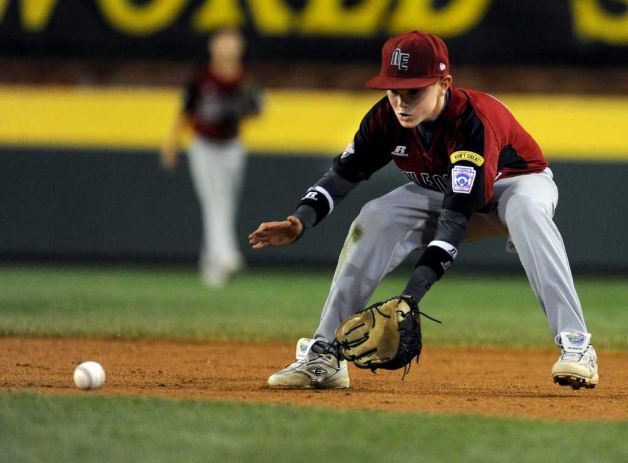
Before focusing on Little League baseball in particular, it is helpful to revisit the goals of youth sports in general according to Hedstrom and Gould:1
- Learning and developing physical skills
- Appreciating the value of fitness
- Building a sense of belonging among one’s peers
- Acquiring sport skill for leisure
- Stimulating physical and emotional growth
- Cultivating a sense of self-worth
- Developing social competence
- Building morals and personal integrity
- Learning to cope with failure**** Added by Josh
Little Leaguers experience morphing of the humeral joint (the bone that runs from the shoulder to elbow) as a result of the throwing motion. This adaptation becomes more significant as a player matures physically and begins to throw harder and more often. These changes in the arm lead to more external rotation of the shoulder, which in turn allows a player to throw harder as he gets older.2
A follow-up study questioned pitchers ten years after pitching in Little League. The researchers questioned the former Little Leaguers about injury, which was defined as elbow surgery, shoulder surgery, or retirement due to throwing injury. Pitchers who pitched 100 innings or more were 350% more likely to be “injured” than their counterparts who threw fewer innings in a years time. I would submit that all of these “injuries” were traumatic, as they either ended or directly affected the careers of the players in question.3
For simplicity’s sake, I will exclude the throwing variables caused by playing catcher, playing on multiple teams, throwing with friends, and participating in practices, scrimmages, and warm-ups from the following example. This example also assumes that a pitcher will throw six innings every three games, as this is the “normal” workload for a Little League pitcher.
Westport Little League:
- Spring Regular Season: 20 games or 40 innings pitched
- Summer District Play: 13 games or 26 innings pitched
- Summer Regional Play: 4 games or 8 innings pitched
- Little League World Series: 6 games or 12 innings pitched
- Total: 43 games or 86 innings pitched
Fall Baseball: 8 games or 24 innings (assuming a pitcher will throw 3 inn. a week)
Total: 51 games or 110 innings
To me, these numbers make clear that a Little Leaguer who pitches approximately six innings per week, plays competitively all summer and continues to play fall baseball will reach that 100 inning number and have a markedly higher risk for serious injury or ending their career.
High School
A study by Dr. James Andrews and his staff surveyed two groups of pitchers with an average age of 18. One group had no history of elbow or shoulder pain lasting longer than two weeks; the second group consisted of pitchers who had either shoulder or elbow surgery due to overuse from pitching. The pain-free pitchers averaged 5 ½ months of competitive baseball per year, while the group that required surgery averaged eight. The results of the study reveal that pitchers who pitch competitively eight months per year are 500% more likely to require shoulder or elbow surgery.
High school baseball pitchers in the northeast may have a slight advantage over their southern counterparts, as the seasons in the northeast are shorter (assuming the pitcher does not have access to a dome in the winter). Northeast baseball is normally played competitively for seven months — from April to August with fall ball in September and October — while southern baseball has virtually no offseason. Thus, the abbreviated season in the northeast protects pitchers from overexertion, while the clement weather in the south, though seemingly a blessing, exposes pitchers to a greater risk of injury.
But I need to play more baseball to get better!
Before worrying about a child’s improvement in a given sport, the child’s health and well-being must be considered. Especially in youth sports, parents and coaches have an obligation to monitor their athletes’ physical and mental health. Indeed, experts have observed that “early specialization is associated with a range of negative consequences affecting physical, psychological, and social development.”4 In addition to keeping athletes healthy, the goal of youth athletics should be to allow each player to fulfill his potential and play as long as he desires.
Even so, it is absolutely true that practice is necessary to progress and become elite in a sport. Scott Kaufman speaks on this subject in his book The Complexity of Greatness: Beyond Talent Or Practice.5
Kaufman also notes that children who play multiple sports are better “learners” because they can utilize their prefrontal cortex more efficiently than single sport youths. Experience in a variety of sports gives an athlete a larger “pool” of skills to draw on when attempting a new sport. One of my favorite examples of this is a former athlete of mine, Dave Boisture. Dave was an all-state quarterback who also played baseball and basketball in high school and eventually played outfield in college. Dave’s “pool” of athleticism was large because he was a stellar multi-sport athlete who learned to run, throw, jump, dodge opponents, adapt to field conditions, and play well under pressure. The following video shows Dave making an incredibly athletic catch while running up an inclined outfield in the high-stakes environment of an NCAA Regional Tournament game.
Dave’s holistic approach to baseball and sports in general was clear during our initial fall testing last year. During testing, each player receives a sheet to fill out which includes position. Dave wrote “athlete” instead of “outfield,” the expected response. Dave’s understanding of himself as an athlete, rather than merely a baseball player, allows him to employ the full array of athletic skills that he has learned over the years. This versatility in turn makes Dave indispensable to his team.
Final Thoughts
Besides the fact that the research shows a direct correlation with extra months of competitive baseball and a significantly higher surgery/drop out rate, I am not a fan of fall baseball in its current format. Normal seasons have players practicing and playing 4-6 times per week, while fall ball often has zero or one practice per week with two to four games on the weekend. Most kids don’t throw or prepare themselves for the games during the week, and take the mound as they would during their summer seasons. In my opinion, this lack of consistent practice and preparation during the fall season is dangerous regardless of the number of innings the pitcher has thrown in the spring and summer months.
I also object to the exploitative nature of many fall leagues. Before I receive all sorts of hate mail, please understand that I am speaking in generalizations and that I appreciate that many programs “get it.” However, I know for a fact that many leagues feel that fall ball is necessary to raise more revenue and make ends meet. I also know that many programs exploit this opportunity to tell players and parents that a kid must play fall ball to keep up with their peers and be considered for an organization’s spring or summer programs. Such programs do a disservice to their players not only ethically but also athletically, as this approach limits players’ athletic growth and increases their risk of career-ending injury.
The research presented in this post deals primarily with pitchers, but I recommend limiting all baseball players to competitive spring and summer seasons only. Playing other sports and practicing baseball skills on the side will allow an athlete to progress as much as early specialization, but it involves a much smaller risk of overuse.
Anecdotally, there is no question to what the correct answer is. Every professional baseball player I have ever worked with was a multi-sport stud in high school. In the rehab setting, I have seen an increasing number of injuries that correlate well to the research and are directly linked to fall baseball.
Related Articles
http://www.kevinneeld.com/2011/hockey-development-resistance
http://www.ericcressey.com/your-arm-hurts-thank-your-coaches
Citations
1. Hedstrom R, Gould D. Research in youth sports: Critical issues status. White Pap Summ Exist Lit. 2004. Available at: http://hollistonsoccer.net/image/web/coaches/CriticalIssuesYouthSports%20(2).pdf. Accessed October 9, 2013.
2. Mair SD, Uhl TL, Robbe RG, Brindle KA. Physeal changes and range-of-motion differences in the dominant shoulders of skeletally immature baseball players. J Shoulder Elbow Surg. 2004;13(5):487–491. doi:10.1016/j.jse.2004.02.008.
3. Fleisig GS, Andrews JR, Cutter GR, et al. Risk of Serious Injury for Young Baseball Pitchers A 10-Year Prospective Study. Am J Sports Med. 2011;39(2):253–257. doi:10.1177/0363546510384224.
4. Baker J, Cobley S, Fraser‐Thomas J. What do we know about early sport specialization? Not much! High Abil Stud. 2009;20(1):77–89. doi:10.1080/13598130902860507.
5. Ford PR, Hodges NJ, Williams AM. CREATING CHAMPIONS THE DEVELOPMENT OF EXPERTISE IN SPORT. Complex Gt Talent Pr. 2013:391.
The Strength-Endurance Continuum
I’ve been asked many times if a push-up is a strength or endurance exercise. The answer: it depends.
If you are first starting to do push up’s and you can only get 2 reps in a set, then obviously you have limited strength in the exercise. Now if you work your way up to 100 reps in a set you have built a base of strength, which allows you to work in the endurance end of the spectrum.
I like to think of pitching in the same light. Depending on the coach, you will get differing thoughts about if pitching is an endurance or explosive movement. I believe it’s both.
The act of pitching is explosive by nature that uses fast twitch muscle fibers in the arms and legs, no pitcher wishes to strive for a slow delivery. The repeated action of throwing a baseball requires more than just explosiveness; it requires endurance from the body to be able to replicate the motion over and over again.
Now many coaches and trainers still believe that the ideal way to train pitchers for the “endurance” aspect of pitching is by running long distances. Not only has this belief been proven to be scientifically flawed, anecdotal evidence points us to believe this is false as well.
Think of a quarterback, whom has the same responsibly (in the throwing aspect) as a pitcher. His job is to be able to repeat the delivery of throwing a football numerous times a game. Now when is the last time you saw a quarterback running miles upon miles to get in shape? I honestly can’t think of one. What you do see is him running sprints with the rest of the team, building up his work capacity of running around the field and throwing the ball throughout the duration of the game. And there is no way in hell that any pitcher runs more than a quarterback in any given game, so why train him that way?
So what about training for the endurance portion of pitching? Throw. Endurance is built through repetition, whether it is push-ups or pitching, repetition is the key to building endurance. That is why it is so important to implement a proper throwing program to build endurance of the pitching motion. Progressive overload is the key; here is a copy of the throwing program I refer coaches and players to. It was published by Mike Reinold, who is an athletic trainer for the Red Sox.
TAKE HOME MESSAGE: Pitchers need to build strength through sprints and strength training and endurance through the act of pitching. Simple, yet very effective.



